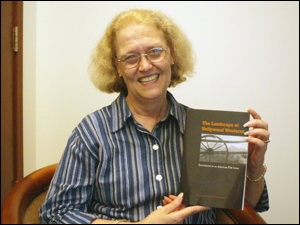Carmichael edits book on Hollywood Western landscapes
Tuesday, October 31, 2006

Land is a tradition, according to Deborah A. Carmichael in her book “The Landscape of Hollywood Westerns: Ecocriticism in An American Film Genre."
Carmichael said that when people around the world think of the Hollywood Western, for example, they get an image of a landscape — wide open spaces and prairies.
“When they think of the American West, the movies have shaped their perceptions of how that land looks,” she said.
When America was settled, people from Europe or England came from small farms or no land holdings at all, so the idea of having a large acreage was unheard of for them, she said.
“The promise of America was land. The openness, the fact that it was unsettled or had a very small population — all that room was astounding for the earliest new Americans," she said.
Carmichael edited and wrote one of the 12 chapters in the book, which The University of Utah Press published. She is currently a Ph.D. candidate in English at Oklahoma State University, where she also teaches as an assistant professor in the Department of English.
“Ecocriticism is a way of looking at a text or a film, to give a different perspective on it, something you may not have paid much attention to, including how land is being photographed or represented,” she said.
The book is not limited to what most people consider “classic Westerns.” The book includes a piece on the classic Hollywood studio western “Stagecoach,” but it also covers documentaries from the 1930s funded by the federal government.
Carmichael points out how even in the movie “Easy Rider,” the characters reverse American frontier expansion by “biking” from the West back to the East. The Clint Eastwood film “Pale Rider” deals with environmental issues, showing how mining companies pillaged resources.
The book also contains numerous photographs and has a filmography listing the movies featured in the book with settings, dates, plots and locations.
Carmichael said that news coverage and films are robust in their images.
“If Oklahoma is in the news, many still have a mindset that Oklahoma is what you see in a Western. The stereotypes are so strong because Americans have carried those images for so long," she said.
When Carmichael came to Oklahoma in 1995, she said her students in New York were concerned that she might be in danger because of the Murrah bombing.
“In their minds, perhaps there was a subconscious connection with Wild West dangers, and the bombing triggered the response that this was a lawless, dangerous environment somehow,” she said.
She credits OSU English Professor Emeritus Leonard Leff, Dr. Jeffrey Walker and Dr. Peter Rollins with mentoring her and encouraging her research work in film, especially in Oklahoma film history, her dissertation topic.
She is an associate editor of the interdisciplinary journal Film & History, along with editor-in-chief Rollins, who contributed an article on the movie, “Tulsa,” which dramatizes multiple perspectives on land use in Oklahoma. She also is co-editing an anthology on sports in film for the University of Kentucky Press.
The University of Northern Illinois Press has contacted her asking for a book proposal on Abraham Lincoln in a film based on her work on “Gabriel Over the White House,” a film from the 1930s that called upon images of Lincoln to advocate a drastic change in Depression-era government.
“It will not be films about Lincoln, but instead movies where this president is alluded to in some way. For example, there is Charlie Chaplin in ‘Modern Times’ sitting in his jail cell with a picture of Lincoln over his shoulder,” Carmichael said. “The image of Lincoln or an allusion to him triggers all those ideas of the Great Emancipator, the rail splitter, ‘Honest Abe,’ all of that mystique that you automatically reference in your mind when you see an image of Lincoln. This response is similar to how cinematic allusions to the West in film evoke very specific imagery.”
Her book on Westerns, which took about two years to complete, is available on Amazon.com, at Barnes and Noble, and in Stillwater at Hastings.
